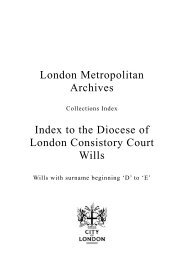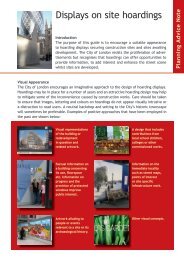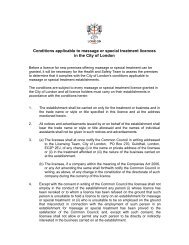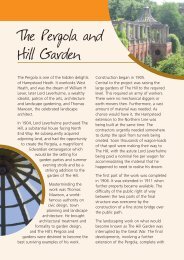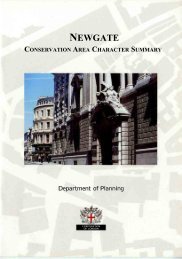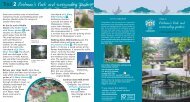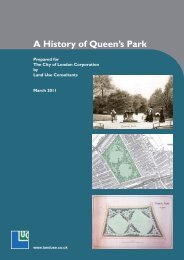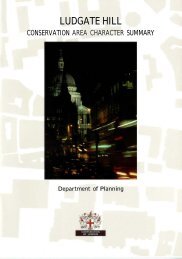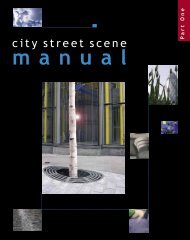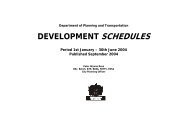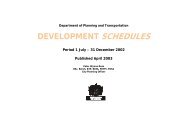Burnham Beeches Management Plan 2010 - the City of London ...
Burnham Beeches Management Plan 2010 - the City of London ...
Burnham Beeches Management Plan 2010 - the City of London ...
You also want an ePaper? Increase the reach of your titles
YUMPU automatically turns print PDFs into web optimized ePapers that Google loves.
2 <strong>the</strong> need for <strong>Management</strong> - pollards<br />
2.1 The importance <strong>of</strong> managing <strong>the</strong> pollards<br />
Areas with ancient beech pollards are rare. In Britain <strong>the</strong>re are<br />
just three sites with over 100 such trees and those in <strong>Burnham</strong><br />
<strong>Beeches</strong> are particularly fine examples. In a worldwide<br />
context, only Romania and <strong>the</strong> Basque Country have more<br />
than just a small handful <strong>of</strong> <strong>the</strong>se trees and <strong>the</strong> climatic<br />
conditions in <strong>the</strong>se places mean that many <strong>of</strong> <strong>the</strong> species<br />
associated with <strong>the</strong> pollarded beech trees <strong>the</strong>re are different.<br />
Pollarding enables beech trees to live much longer than<br />
those left unpollarded (maidens): <strong>the</strong>y can live for over 400<br />
years ra<strong>the</strong>r than <strong>the</strong> more normal 250. The aging process,<br />
toge<strong>the</strong>r with <strong>the</strong> pollarding action gives <strong>the</strong> trees <strong>the</strong>ir<br />
characteristic and knobbly shape. Rainwater and fungi<br />
slowly break down <strong>the</strong> dead wood in <strong>the</strong> trunks <strong>of</strong> <strong>the</strong><br />
trees - this does not harm <strong>the</strong> tree but is a natural aging<br />
process. These water and decay pockets provide ideal<br />
conditions for invertebrates and <strong>the</strong> aging process enables<br />
species <strong>of</strong> moss and lichen to live on <strong>the</strong> bark <strong>of</strong> <strong>the</strong>se<br />
trees ra<strong>the</strong>r than younger ones.<br />
Once <strong>the</strong> process <strong>of</strong> pollarding has started it needs to be<br />
continued. Trees uncut for many years develop very large<br />
and heavy branches, become unstable and fall over or fall<br />
apart. This is just what has<br />
happened in <strong>Burnham</strong> <strong>Beeches</strong>.<br />
The pollards were last cut regularly over 200 years ago.<br />
This, coupled with <strong>the</strong> cessation <strong>of</strong> grazing by <strong>the</strong> 1930’s<br />
(leading to new young trees growing around <strong>the</strong> old<br />
ones), means that <strong>the</strong> branches reach up high for light as<br />
well as growing larger in girth. By 1980 many <strong>of</strong> <strong>the</strong> old<br />
pollards were becoming very unstable. In addition <strong>the</strong>re<br />
was no new generation <strong>of</strong> pollards as <strong>the</strong> youngest were<br />
still probably 350 years old or more.<br />
It was estimated by a forester in <strong>the</strong> 1930’s that at one time<br />
<strong>the</strong>re may have been over 3,000 pollards in <strong>Burnham</strong> <strong>Beeches</strong>.<br />
By 1990 <strong>the</strong> number had declined to 550 and by 1999 <strong>the</strong><br />
trees were dying at a rate <strong>of</strong> approximately 8.5 every year.<br />
Since <strong>the</strong>n a programme <strong>of</strong> restoration work was started<br />
but restoring lapsed pollards was a new science - one that<br />
staff at <strong>Burnham</strong> <strong>Beeches</strong> were in <strong>the</strong> forefront <strong>of</strong><br />
developing. Techniques have been refined over <strong>the</strong> last<br />
20 years, but we are still learning. The rate <strong>of</strong> loss <strong>of</strong> <strong>the</strong><br />
old trees has now declined to less than 6.4 trees every<br />
year. Continuing this work programme, which also<br />
includes work to create new pollards for future, is an<br />
important part <strong>of</strong> our work.<br />
In addition, grazing needs to be reinstated to all areas<br />
with pollards in order to stop scrub and young trees<br />
growing up and stopping light from reaching <strong>the</strong> old trees.<br />
(1) (2) (3) (4) (5) (6)<br />
18<br />
1: A tree pollarded regularly and in<br />
a grazed system.<br />
2: A ‘lapsed pollard’. It has not been<br />
cut for many years: <strong>the</strong> branches<br />
are tall and heavy. Young trees<br />
grow aound it because grazing has<br />
stopped.<br />
3: Wind and <strong>the</strong> weight <strong>of</strong> <strong>the</strong><br />
branches make <strong>the</strong> tree unstable<br />
and vulnerable to wind damage.<br />
4: Old pollards can be restored.<br />
First stage <strong>of</strong> restoration: young<br />
trees are cleared from close to <strong>the</strong><br />
pollard and <strong>the</strong>re is a gentle<br />
reduction in <strong>the</strong> height and weight<br />
<strong>of</strong> <strong>the</strong> branches.<br />
5: Second stage <strong>of</strong> restoration: <strong>the</strong>re<br />
is a fur<strong>the</strong>r reduction in height and<br />
weight on <strong>the</strong> branches; a little<br />
more clearance <strong>of</strong> young trees has<br />
been done.<br />
6: After several restoration stages<br />
<strong>the</strong> pollard is much lower again and<br />
more stable. It is now cut on a<br />
regular cycle. New pollards are<br />
nearby to replace <strong>the</strong> old ones when<br />
<strong>the</strong>y die. Animals graze underneath<br />
<strong>the</strong>m once again.



